|
|
 |
|
Baths & Bathing as an Ancient Roman |
|
written
by kjw2 / 09.13.2004 |
|
|
| |
Introduction |
| |
| |

|
| from <http://people.clemson.edu/~elizab/rdlimages.htm> |
| Diagram of a Hypocaust |
| The hypocaust was a furnace which efficiently heated the baths from under the floor. |
| |
|
| |
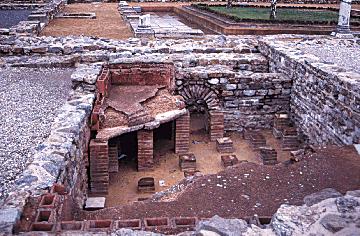
|
| from <http://people.clemson.edu/~elizab/rdlimages.htm> |
| Ruins of an Ancient Hypocaust |
| This isn't the hypocaust at the Stabian Baths, but it is a good example of what they look like. You can see the pillars which supported the floor, and the remains of the floor. The arch at the rear of the room was where the furnace was, and where the hot air from the furnace entered the space under the floor. |
| |
|
Bathing was a custom introduced to Italy from Greece towards the end of the 3rd century B.C. Early Romans washed their arms and legs everyday, which were dirty from working, but only washed their whole bodies every nine days. They also swam in the Tiber. Some took occasional hot baths in the lavatrina- a room next to the kitchen. Later, when the custom of daily bathing in hot baths took hold, Romans began to build bathrooms (balnea) in their houses. In the 2nd century B.C. the first bathhouses were built. In 33 B.C. there were 170 small baths in Rome; by early 5th century that number had climbed to 856.
Baths in the Roman Empire were provided water by the extensive aqueduct systems built by the Romans. Water supplies for public baths usually took priority over water for private use. Baths that needed to, such as small baths or baths in arid areas, could function with very little water input, keeping water in reservoirs and cisterns. Other baths, in areas where water was more readily available, used a generous supply of water from the aqueducts in order to maintain their stylish displays such as fountains and cascades. During the time of Trajan (AD 100), there were nine aqueducts that supplied Rome with about 1 million cubic meters of water daily, an estimated 300 gallons per person per day. Rome has not seen anything near this impressive a supply of water until modern times.
A key invention in the history of baths was the hypocaust which was invented at the end of the 2nd century BC. Though evidence of the floor heating systems exists in earlier models, it seems that the Romans really developed and perfected this technology. Since cold baths could hardly gain the popularity that hot baths could, the invention of the hypocaust caused bathing to take off as a cultural phenomenon. The hypocaust is a furnace, and the hot gasses from the hypocaust were allowed to circulate in a 2 foot space beneath the floors of the baths. The floor was usually supported by pillars of bricks, terracotta or stone, with 0.6 meter square tiles resting on top. Chimneys and pipes circulated the hot air through the space under the floor so that the fire from the furnace never touched the floor of the baths. Later on, Romans began to make the walls of the baths hollow allowing the hot gasses to circulate within the walls, after heating the floor, heating them to about body temperature. This allowed Romans to put windows in the wall because they could use the hot air within the walls to compensate for the heat lost throught the windows. Holes in the walls allowed them to control the temperature and moisture, making the baths pleasant and luxurious to be in. The hypocaust thus allowed the Romans to heat the water, walls and air of their baths efficiently, turning a hygienic chore into a cultural phenomenon, truly establishing bathing as a daily necessity.
|
| |
|
| |
|
| |
Description |
| |
| |
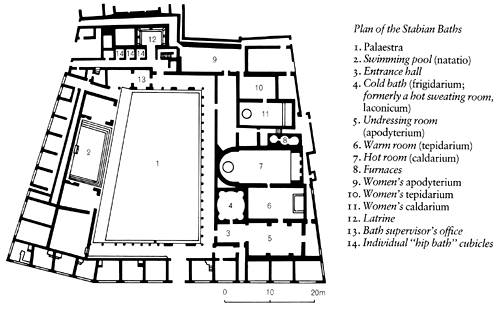
|
|
| Floor Plan of the Stabian Baths |
| You can see on the floor plan that the Stabian Baths had separate facilities for men and women, a large palaestra and a laconicum. |
| |
|
| |

|
| from: <http://www.vroma.org/~bmcmanus/baths.html> |
| 3D plan of the Stabian Baths |
| This diagram gives you a better idea of what the Stabian Baths complex would have looked like in the early 1st century. |
| |
|
| |

|
| www.vroma.org/ ~bmcmanus/baths.html |
| Piscina at the Stabian Baths |
| This is the pool most like a modern swimming pool at the baths. It was shallow and was likely used only for light swimming. |
| |
|
There are three main public baths in Pompeii: the Forum Baths, the Central Baths and the Stabian Baths. All three baths were initially supplied water from the River Sarno and local wells, but later they were supplied by the aqueduct which brought water from the nearby hills. The Forum Baths were built in 80 B.C., close to the main forum, and were the smallest but most elaborately decorated of the three baths. The Central Baths were situated in the center of Pompeii and the Stabian Baths were situated at the junction between two of Pompeii’s main roads – the via dell’Abbondanza and the Via Stabiana and they are the oldest baths in Pompeii.
The Stabian baths, built at the end of the 2nd century, represent the earliest known use of the hypocaust. The Stabian baths are also important because they are some of the earliest and best preserved examples of baths from the republican period. The north wing dates back as early as the fourth century, but the double zones, with the palaestra, is from the second century. The circular laconicum was added during a restoration in 80 B.C. and was later turned into a frigidarium with the construction of the pool early in the 1st century. At the time of the eruption, most of the building was under construction; only the women’s section had been completely renovated. Most of this construction is probably because of the earthquake in 62 A.D., however, baths were constantly evolving, being updated and remodeled to keep with the trends of the time.
Both the Stabian and the Forum baths have separate facilities for men and women, which share a heating system. Few other baths throughout the empire had separate bathing facilities for men and women; it was more common (and certainly more cost effective) to have separate bathing hours for men and women. The women’s facilities are smaller and their apodyterium doubled as a figidarium, containing a small pool of cool water. Unlike later, larger and more elaborate baths in the Roman empire, the palaestra at the Pompeian baths doesn’t contain libraries or lecture halls to serve an educational purpose. The palaestra does contain a shallow (1-2 meter) piscina or pool and it is surrounded by a shady portico, where visitors could walk, talk and watch the exercisers. This piscina, like many others found in Roman baths, is too shallow and too short for competitive or rigorous swimming so it was probably was just used for leisurely activity. The Stabian baths, like other baths from the republican period, were simpler and darker than later, more elaborate bath houses. The philosopher Seneca contrasted “the overly lighted contemporary baths with the welcome darkness of the old ones such as the Stabian Baths or the Forum Baths in Pompeii” (Yegul 40). The Stabian baths thus offer us a well preserved snapshot of an early republican bath that laid the foundations for daily bathing to explode as a popular daily activity throughout the Roman empire.
|
| |
|
| |
|
| |
Function |
| |
| |

|
| ~bmcmanusbaths.html > |
| Oil Flask and Strigils |
| A visitor to the baths would have carried an oil flask and strigils like this. They might also carry towels, bathing attire and perfume. |
| |
|
| |
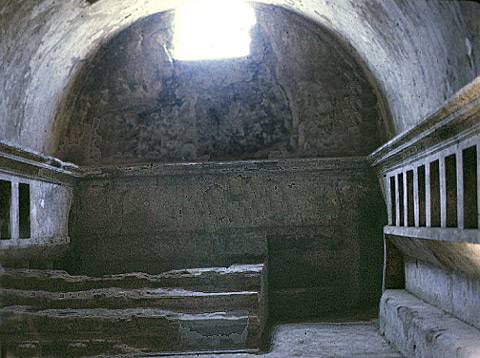
|
| www.vroma.org/ ~bmcmanus/baths.html |
| Frigidarium and Women's Dressing Room |
| This room had two functions, it was the women's changing room and it functioned as the women's cold room (frigidarium) with a small cold pool in the other end. The men had separate and larger changing and cold rooms. |
| |
|
| |
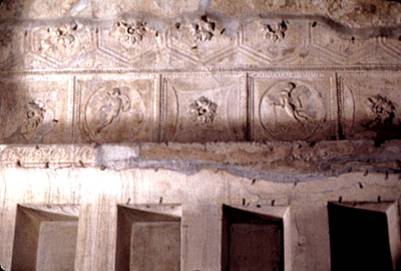
|
| www.vroma.org/ ~bmcmanus/baths.html |
| A Dressing Room Niche |
| This niche at the Stabian Baths was used to store clothes in. You can see some traces of decorations that used to be on the walls. |
| |
|
| |
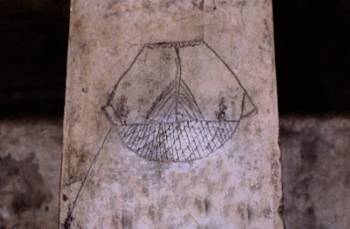
|
| www.vroma.org/ ~bmcmanus/baths.html |
| Grafito of Ship |
| A close up of a Grafito of a Ship scratched on a post between two niches in the dressing room. |
| |
|
Romans typically frequented the baths at around 2 in the afternoon (during the Roman 8th hour) after the workdeay ended at about noon and before dinner which was taken in late afternoon or early evening. Baths were loud and crowded. One description by Seneca, a philosopher who lived in an apartment above a public bath, describes “the assortment of sounds which are enough to make me hate my very powers of hearing” (Paoili 225). Seneca bitterly describes the sounds of straining weightlifters, pummeling masseuses, shouting scorekeepers, splashing swimmers, singing bathers, and the advertising cries of the armpit hair-plucker, and the wails of his customers. In spite of the noise and activity, the baths were a luxurious place to spend the afternoon. They were lavishly decorated, the walls, floors and ceilings covered in beautiful colored marble, mirrors and mosaics accented with bronze or silver faucets. The hot air circulating throughout the walls from the hypocaust would have made the walls pleasantly warm to the touch and the air was probably warm and well circulated. High ceilings and large windows would have given the baths a light and spacious feel. Hungry patrons could pickup a snack at any of the stands within and around the baths. They could be massaged by professional masseurs and sit and sweat in a sauna-like hot room, the laconicum. Since the bathing ritual took a long time, going from room to room, the baths were a place to socialize and meet friends to catch up on the latest gossip or discuss politics.
After arriving at the bath, a typical citizen would change clothes in the apodyterium, or changing room, storing their clothes in little niches or cubbies. Wealthier patrons would pay a slave to keep watch over their belongings, while poorer patrons could pay the attendant to keep an eye on them. There was probably usual bathing attire, though the nature and extent of this bathing attire is debated (see discussion on nudity in the baths in the last section of this report). It is known that they wore special sandals called sculponea with thick wooden soles to protect their feet from the heated floors. In general, after changing Romans were rubbed down with oil by a slave then they exercised in the palaestra. Exercise wasn’t supposed to be strenuous, rather they worked out only until they worked up a light sweat. Possible exercises included walking, running, reading aloud, mild weight lifting, wrestling and various ball games. There were lighter exercises which were deemed appropriate for women, such as rolling a hoop with a stick or swimming. After exercising they would scrape the dust and oil from their skin using a strigil, a curved metal instrument originally used by Greek athletes. After this, they would bathe, alternating temperatures as they alternated rooms. Romans weren't required to visit the rooms in any particular order, but the generally bathers would visit the hot room, the caldarium first. It contained a bath or a small pool of hot water, and the air was warm. Some caldariums had a labrium, a small waist high basin of cold water with which bathers could splash themselves. After the caldarium bathers could go to the warm room, the tepidarium, as a transition before the cold room. Bathers could finish off with a refreshing dip in the cold pool of the frigidarium. There were several other types of optional rooms found in some of the later and more elaborate baths. A solarium or heliocaminus, was a room with unglazed windows for sunbathing. The Stabian Baths contain a laconicum, a superheated sweat bath like a sauna. Other baths could contain a sudatorium which was similar to a laconicum, except it had humid instead of dry heat. There could be a room for anointing with oil, the unctorium, and gardens, libraries and lecture halls off the palaestra. Bathing ritual would change according to the trends and medical recommendations of the day and baths would remodel and evolve to fit consumer demands.
At the end, visitors would finish off their bathing experience by drying off with linen towels and being anointed with perfumes and oils. After bathing it was customary to go home and eat a long dinner, the main meal of the day. Baths functioned as a meeting place for guests before a dinner party (bathing after dinner usually did not occur, as Romans were fully aware of the potentially fatal combination of swimming and a full stomach). Some Roman writers complained that some people would even seek out dinner invitations at the baths by being obsequious, annoying, or even harassing. The Roman bathing establishment was a combination of a modern day spa, country club, community center, coffee shop and library. The bathing experience, as the Romans defined, it remains unequaled in American society today.
|
| |
|
| |
|
| |
Patron |
| |
| |
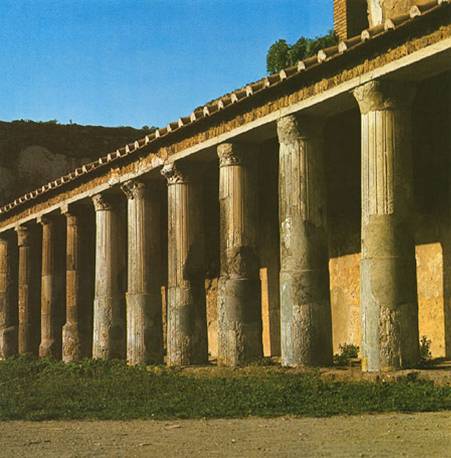
|
| http://www.vroma.org/~bmcmanus/baths.html |
| Portico at the Stabian Baths |
| This portico wrapped around two thirds of the palaestra at the Stabian baths, and it was a shady place where people could walk and talk while watching people exercise in the palaestra. This picture, gives one the impression that the baths were once an elegant and pleasant place to spend the afternoon. |
| |
|
Government officials and prominent wealthy people in society made maintaining and building baths one of their top priorities, striving to make them as attractive and accessible as possible. The patron of the Stabian baths would have gained popularity through their construction. In attempts to please the people and gain popularity, a wealthy or influential person might fund the waiving of the entrance fee at certain baths for a period of time. When the people did have to pay the nominal entrance fee, the baths were still cheap; women usually paid twice as much as men. Therefore, all classes of Roman society took daily hot baths, but not necessarily in the same place. The wealthy had their own extensive private baths, but still would frequent the public baths since bathing was considered a social activity. There were small private baths with restricted clientele, larger public baths, balnea meritoria, privately owned, built and run for profit. Slaves would bath in bathing facilities in the house where they worked or use designated facilities at public baths.
The most public baths, thermae, were gifts to the people by rich citizens or emperors and they were run by a conductor. There is some dispute over the terminology regarding the difference between a thermae and a balnea. Thermae were larger and generally more luxurious than balnea. Thermae were decorated in marble and had more ornate refinements, while balnea were decorated with stucco and were more poorly lit, though both terms seem to be applied liberally to many different types of baths. Perhaps like the difference today between a country club and a public pool, however the both terms are used to refer to both public and private baths.
Different levels of luxury were associated with different types of baths and some baths were more fashionable than others. Just like bars or restaurants today, baths could be trendy or passé and certain baths could pass in and out of style. It was common in polite society to inquire of a stranger which baths he used. The Stabian baths were much simpler and darker than their elaborate successors because they were older and located in a city outside of Rome; they appealed to those with a stoic sense of simplicity.
|
| |
|
| |
|
| |
Conclusion |
| |
| |
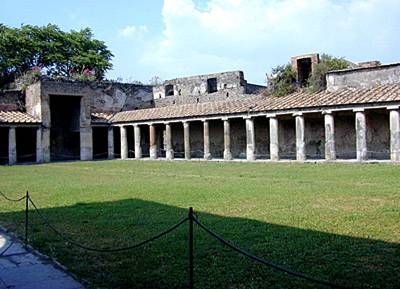
|
| www.vroma.org/ ~bmcmanus/baths.html |
| Palaestra |
| This is the square in which bathers would exercise as a prelude to bathing. Exercise was light and after finishing, exercisers would scrape the dirt, oil and sweat off their bodies using a strigil (pictured above). |
| |
|
| |
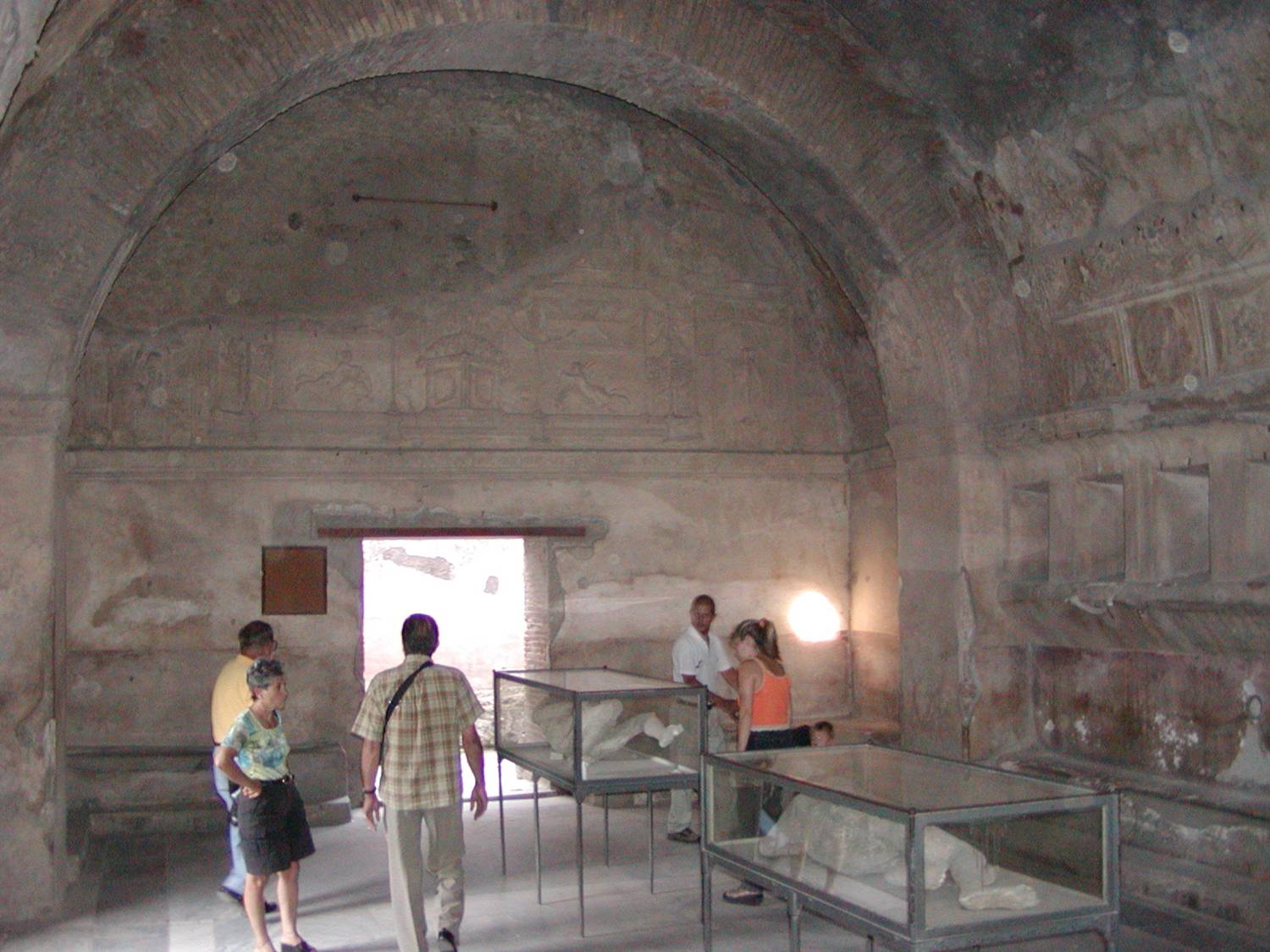
|
| http://sights.seindal.dk/photo/9736,s722f.html |
| Tourists at the Stabian Baths |
| The tourists are examining the plaster casts of some of the victims of Vesuvius' eruption in A.D. 79. |
| |
|
Living the busy, fast-paced American lifestyle, it’s hard to imagine taking a few hours every day to relax and socialize. Yet to the Romans, a bath was a necessary part of the daily routine. Baths institutionalized leisure. Besides keeping the Romans clean, the baths provided a space for many other cultural and social activities. Bathing represented a balance between the body and mind, many baths incorporating lecture halls and libraries. Bathing alone was unheard of, to the Romans bathing was a social activity. Baths provided a place for friends and neighbors to meet and socialize, thus building community among the Romans. Since they were so cheap, all classes of Roman society could enjoy them side by side in a classless environment. Politicians and the very wealthy would frequent the baths, even though they had their own private facilities, to rub shoulders with the common citizens. Baths were considered a principle element in good health, along with diet, exercise and massage, the latter two also being available at the baths. Baths were considered the embodiment of the ideal way of urban life in the Roman world, a hallmark of civilized culture and a daily necessity for health and well-being. We can look back on the institution of bathing and learn from the Romans that it is possible set aside time every day for socializing, health and leisure and still be one of the most powerful empires in history.
|
| |
|
| |
|
| |
Personal Observations |
| |
| |
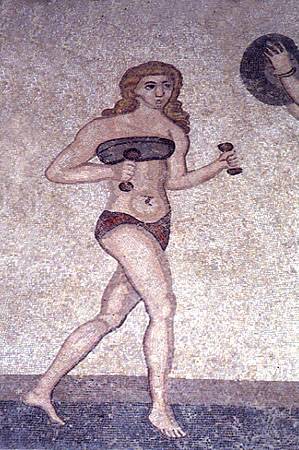
|
| http://www.vroma.org/~bmcmanus/baths.html |
| Mosaic of Exercising Woman |
| This woman is most likely competing in an athletic competition, as weight lifting was usually not an acceptable form of exercise for women. Could her attire be typical bathing attire? |
| |
|
Bathing in American culture is considered a private activity, and I was interested in the cultural impact of public bathing. I was most surprised to learn about the positive impacts public baths had on community, social life and culture. However, there was also a darker side to the public baths. They were an ideal place for prostitutes to solicit customers and they were considered an appropriate prelude to a purchased sexual encounter. There were also many criticisms of their increasing and sometimes excessive luxury and the impact so much leisure was having on Roman society.
I was particularly curious to find out whether or not the Romans bathed in the nude. I learned that the roman word for being naked is "nudus" which also refers to being scantily or improperly dressed. This makes it difficult for modern scholars to determine exactly how nudus the Roman bathers were, though there is evidence that sometimes they did sometimes bath naked. There is also ample evidence for associated bathing attire, including bathing robes worn on the way home or in the palaestra (exercise area) and sculponea, sandals with wooden soles for the heated floors.
Just as baths existed at varying levels of luxury, they also existed at varying levels of propriety. At one extreme were the less respectable establishments where prostitutes bathed with (and presumably solicited) men. At the other extreme were bath houses with separate facilities for men and women, or bath houses that were open to women in the morning and men in the afternoon. There is evidence that men and women did bath together completely naked in respectable bath houses, though the prevalence of this practice is debated. Several imperial decrees against co-ed bathing were issued by emperors, such as Hadrian, indicating that this practice was widespread. There is evidence that noble women did frequent the mixed bathhouses, and that mixed bathing was completely normal in certain circles. No clear cut line between mixed and non mixed bathing can be easily established, whether chronological or economical, so the matter was most likely a personal choice that varied between persons, regions, and establishments. This is probably analogous to nude sun bathing in Europe, as it happens in some places and not in others, and there really is no particular pattern governing its occurrence.
I think the most surprising thing I learned while researching the baths was that in addition to their cultural function, they served an architectural function as well. Since baths were a well funded public endeavor, but they were less formal than monuments and temples, they served as an excelent playing ground for Roman architects to experiment with new and innovative building styles. The dome is one example of an architectural style that was first tried in a bath house and later used in monuments and temples.
|
| |
|
| |
|
| |
Bibliography |
| |
1. Paoili, Ugo Enrico. Rome: Its People Life and Customs. London: Longmans, Green & Co., 1963.
2. Fagan, Garrett G. Bathing in Public in the Roman World. Ann Arbor: U of Michigan P, 1999.
3. Yegul, Fikret. Baths and Bathing in Classical Antiquity. U.S.A.: MIT, 1992.
4. McManus, Barbara F. Roman Baths and Bathing. July 2003 [accessed July 2004].
5. Liverpool College: The Roman Baths. [accessed July 2004].
|
| |
|
| |
|
|
 |
|













